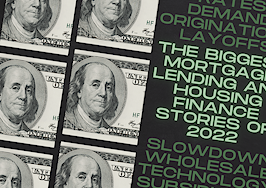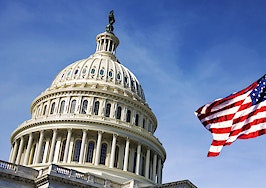New markets require new approaches and tactics. Experts and industry leaders take the stage at Inman Connect New York in January to help navigate the market shift — and prepare for the next one. Meet the moment and join us. Register here.
Demand for home loans tailed off at the end of the year even after adjusting for seasonal factors, but mortgage rates remain well below 2022 highs as the spring homebuying season approaches, according to a weekly lender survey by the Mortgage Bankers Association.
The MBA Weekly Mortgage Applications Survey shows demand for purchase loans was down a seasonally adjusted 12.2 percent last week compared to two weeks before and 42 percent from a year ago.
Requests to refinance were down 16.3 percent last week from two weeks before and 87 percent from the same time a year ago.

Joel Kan
“The end of the year is typically a slower time for the housing market, and with mortgage rates still well above 6 percent and the threat of a recession looming, mortgage applications continued to decline over the past two weeks to the lowest level since 1996,” said MBA Deputy Chief Economist Joel Kan in a statement. “Purchase applications have been impacted by slowing home sales in both the new and existing segments of the market. Even as home-price growth slows in many parts of the country, elevated mortgage rates continue to put a strain on affordability and are keeping prospective homebuyers out of the market.”
Mortgage rates retreat from 2022 highs
Rates on 30-year fixed mortgages were under 3.5 percent at the beginning of 2022 but more than doubled as the Federal Reserve hiked rates seven times to fight inflation. After climbing to a 2022 high of 7.16 percent on Oct. 24, 30-year fixed-rate mortgage rates have retreated as bond market investors anticipated the Fed’s decision to slow the pace of interest rate hikes in December.
But since hitting a recent low of 6.24 percent on Dec. 15, rates on 30-year fixed loans have climbed more than 25 basis points, hitting 6.53 percent on Jan. 3, according to loan lock data tracked by Optimal Blue.
Minutes of the Fed’s Dec. 14 meeting released Wednesday show policymakers are aware that higher mortgage interest rates have “notably restrained housing activity and that they expected housing activity to remain weak. A couple of participants remarked on anecdotes or concerns from builder contacts about contract cancellations by purchasers no longer able to qualify for loans at higher interest rates.”
But with inflation still well above the Fed’s target range, policymakers have telegraphed their intentions to continue making smaller increases in the short-term federal funds rate this year.
After raising rates seven times by a total of 4.25 percentage points in 2022, policymakers would only need to make two or three smaller adjustments this year to bring the federal funds rate to just above 5 percent, the current “dot plot” projection of where short-term rates need to be to put a damper on inflation.
Some economists are projecting that the Fed’s rate hikes will trigger a recession this year. The dot plot shows Fed policymakers expect to start bringing short-term interest rates back down in 2024 and 2025.
But long-term interest rates, including Treasury yields and mortgage rates, are projected to ease this year as the economy slows.
Mortgage rates expected to fall

Source: Fannie Mae December 2022 housing forecast, MBA housing forecast
Economists at Fannie Mae project rates on 30-year fixed-rate loans peaked during the fourth quarter of 2022 and could dip below 6 percent by the first quarter of next year. In a Dec. 19 forecast, economists at the MBA projected rates will fall to 5.2 percent by the end of next year and average 4.4 percent during the second half of 2024.
For the week ending Dec. 20, the MBA reported average rates for the following types of loans:
- For 30-year fixed-rate conforming mortgages (loan balances of $647,200 or less), rates averaged 6.58 percent, up from 6.42 percent. With points increasing to 0.73 from 0.65 (including the origination fee) for 80 percent loan-to-value ratio (LTV) loans, the effective rate also increased.
- Rates for 30-year fixed-rate jumbo mortgages (loan balances greater than $647,200) remained unchanged at 6.12 percent. But with points increasing to 0.45 from 0.37 (including the origination fee) for 80 percent LTV loans, the effective rate increased.
- For 30-year fixed-rate FHA mortgages, rates averaged 6.45 percent, up from 6.41 percent. With points increasing to 1.24 from 1.13 (including the origination fee) for 80 percent LTV loans, the effective rate also increased.
- Rates for 15-year fixed-rate mortgages averaged 6.06 percent, up from 5.97 percent. With points increasing to 0.70 from 0.57 (including the origination fee) for 80 percent LTV loans, the effective rate also increased.
- For 5/1 adjustable-rate mortgage (ARM) loans, rates averaged 5.61 percent, up from 5.45 percent. Although points decreased to 0.62 from 0.95 (including the origination fee) for 80 percent LTV loans, the effective rate also increased.
Get Inman’s Extra Credit Newsletter delivered right to your inbox. A weekly roundup of all the biggest news in the world of mortgages and closings delivered every Wednesday. Click here to subscribe.













